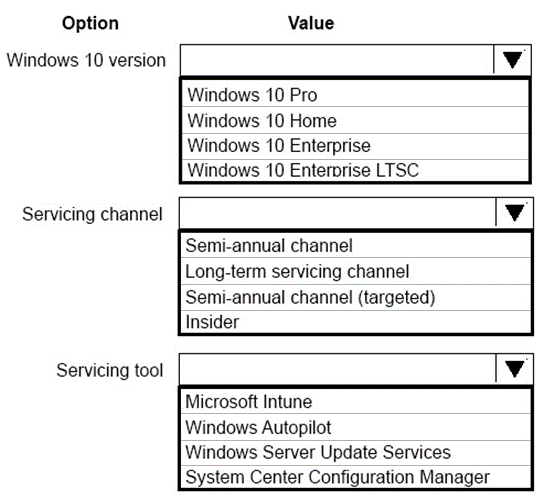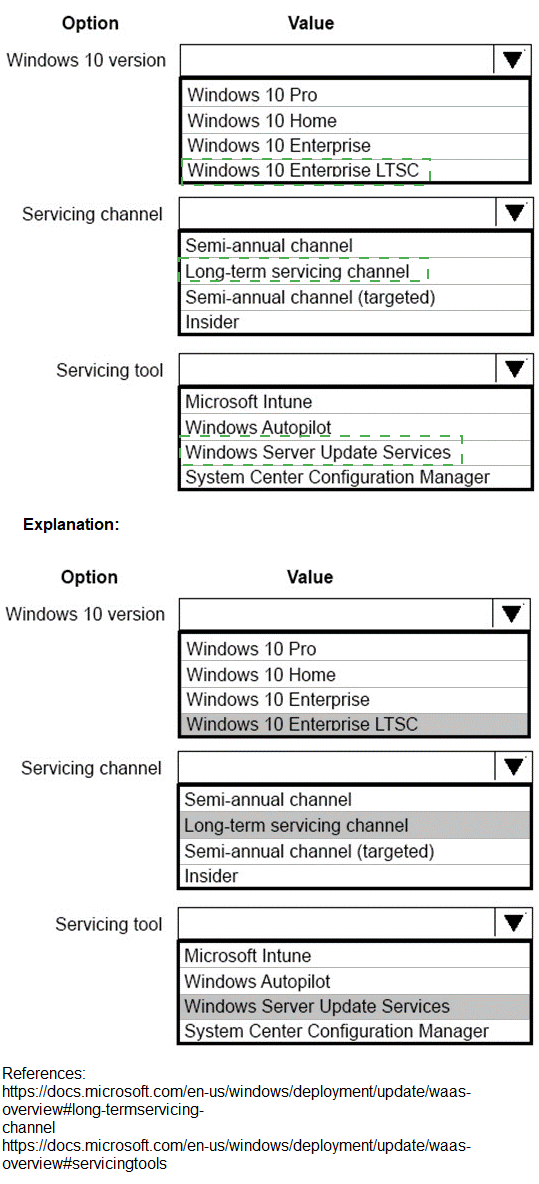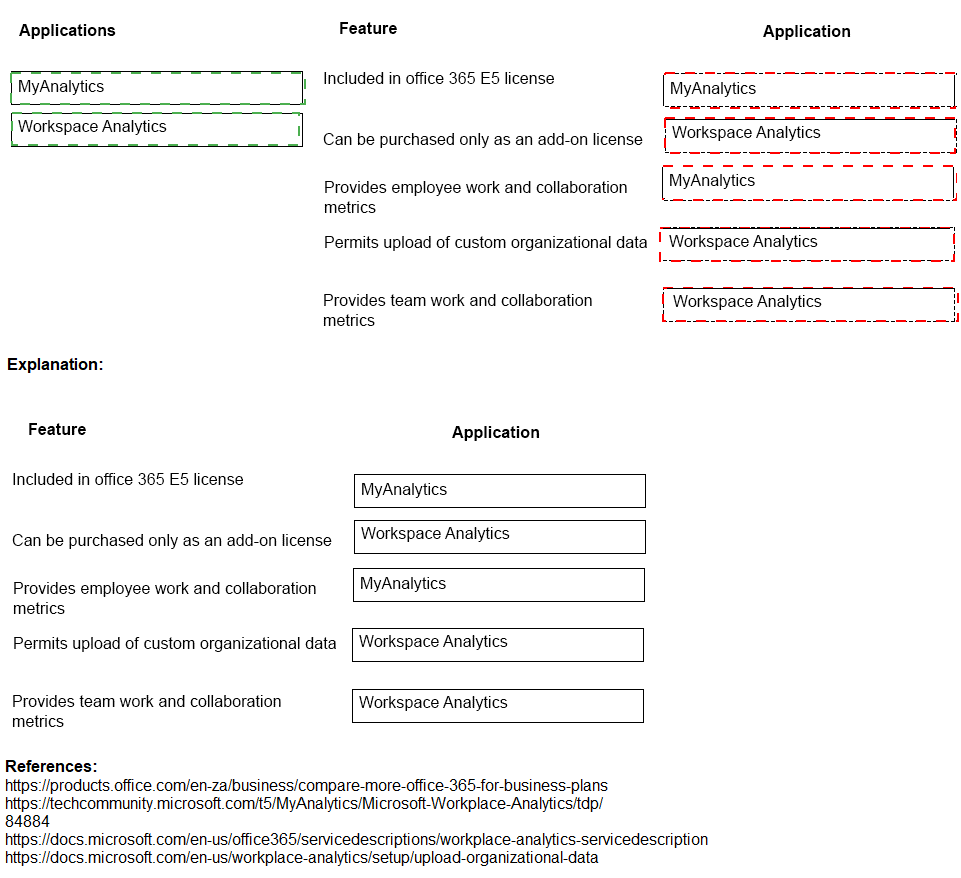A company plans to migrate on-premises infrastructure to the cloud.
What are three benefits of migrating to the cloud? Each correct answer presents a complete solution.
NOTE: Each correct selection is worth one point.
A.
Reduce configuration requirements on desktop computers
B.
Reduce on-site network latency
C.
Automate data backup and disaster recovery
D.
Scale and extend applications.
E.
Eliminate the cost of buying server hardware.
Automate data backup and disaster recovery
Scale and extend applications.
Eliminate the cost of buying server hardware.
Explanation:
C: Most cloud providers help to improve business continuity by offering built-in, one-click
backup and recovery capabilities. Some providers also offer the ability to store backups in
different geographic regions.
D: When demand spikes or the organization needs more powerful compute resources,
organizations can alter their resources instantly on demand.
E: There are significant savings in resource, maintenance, and real estate costs, in addition
to the ability to optimize workloads so that they cost less to run.
Reference:
https://azure.microsoft.com/en-us/overview/cloud-migration-benefits-challenges/#overview
A company is migrating to Microsoft 365.
The company is reviewing the billing account options in Microsoft 365.
You need to recommend a billing account options. Which billing account type should you
recommend?


You are the Microsoft 365 administrator for a company.
You need to track scheduled maintenance events in Microsoft 365 admin center.
Where can you track these events?
A.
Reports
B.
Support
C.
Service Health
D.
Message Center
Message Center
Explanation:
https://docs.microsoft.com/en-us/office365/servicedescriptions/office-365-platform-servicedescription/
service-health-and-continuity
You are a Microsoft 365 administrator for a company.
What are two ways that you can ensure data security? Each correct answer presents a
complete solution.
NOTE: Each correct selection is worth one point.
A.
service-level encryption using customer-provided key
B.
tenant-dedicated Microsoft Azure AD encryption using customer-provided key
C.
single-tenant infrastructure partitions for sensitive data
D.
data transfer using transport-layer security (TLS)
service-level encryption using customer-provided key
data transfer using transport-layer security (TLS)
Explanation: https://docs.microsoft.com/en-us/microsoft-365/compliance/customer-keyset-
up?view=o365-
worldwide#:~:text=With-Customer-Key%2C-you-control,to-them%2C%2
0with-their-keys
A company plans to purchase Microsoft 365.
You need to give management an overview of the Microsoft 365 pricing model.
Which of the following describes how the company will be billed for Microsoft 365?
A.
The company will be charged according to the amount of computing resources it uses
each month across
all users.
B.
The company will make a single payment for Microsoft 365, after which it owns the
license for Microsoft
365 and can use it in an unlimited fashion.
C.
The company will be charged annually for a single Microsoft 365 license that can be
shared among all
employees.
D.
The company will be charged according to the number of user licenses required.
The company will be charged according to the number of user licenses required.
Instructions: For each of the following statements, select Yes if the statement is true.
Otherwise, select No.
NOTE: Each correct selection is worth one point.


A company has Microsoft 365 and uses Microsoft Endpoint Manager.
You need to identify the endpoint management tool associated with each action.
Which tool should you identify for each action? To answer, drag the appropriate tools to the
correct actions. Each tool may be used once, more than once, or not at all. You may need
to drag the split bar between panes or scroll to view content.
NOTE: Each correct selection is worth one point.


You manage point-of-sale terminals that run Windows 7.
You must upgrade the terminals to Windows 10. Terminals must not be upgraded again for
at least five years. You have the following requirements:
Perform consistent scheduling of upgrades and updates across all devices.
Minimize costs.
You need to prepare for the upgrades.
What should you use? To answer, select the appropriate options in the answer area.
NOTE: Each correct selection is worth one point.


You are evaluating Office 365 ProPlus for a company. For each of the following statements, select Yes if the statement is true. Otherwise, select
No.
NOTE: Each correct selection is worth one point.


A company is evaluating Microsoft 365.
You need lo identity the benefits of an Enterprise Agreement.
What is a benefit of an Enterprise Agreement?
A.
All licenses are perpetual
B.
Simplified per-device licensing model
C.
Simplified non-expiring licensing model
D.
Locked-in pricing for the duration of the term.
Simplified non-expiring licensing model
You are the Microsoft 365 administrator for a company.
You need to identify the different features of MyAnalytics and Workspace Analytics.
What are the different features? To answer, drag the appropriate applications to the correct
features. Each application may be used once, more than once, or not at all. You may need
to drag the split bar between panes or scroll to view content.
NOTE: Each correct selection is worth one point.


You are a Microsoft 365 administrator for a company.
Several users report that they receive emails which have a PDF attachment. The PDF
attachment launches malicious code.
You need to remove the message from inboxes and disable the PDF threat if an affected
document is opened.
Which feature should you implement?
A.
Microsoft Exchange Admin Center block lists
B.
Sender Policy Framework
C.
Advanced Threat Protection anti-phishing
D.
zero-hour auto purge
E.
DKIM signed messages with mail flow rules
zero-hour auto purge
Explanation:
Explanation Zero-hour auto purge (ZAP) is an email protection feature in Office 365 that
retroactively detects and neutralizes malicious phishing, spam, or malware messages that
have already been delivered to Exchange Online mailboxes. ZAP is available with the
default Exchange Online Protection (EOP) that's included with any Office 365 subscription
that contains Exchange Online mailboxes. ZAP doesn't work in standalone EOP
environments that protect on-premises Exchange mailboxes
https://docs.microsoft.com/en-us/microsoft-365/security/office-365-security/zero-hour-autopurge
| Page 10 out of 26 Pages |
| Previous |